Strategic Finance Report: Samsung Plc Financial Analysis
VerifiedAdded on 2023/03/21
|13
|3263
|38
Report
AI Summary
This comprehensive finance report analyzes financial data and its sources, including income statements, balance sheets, and cash flow statements, crucial for strategic business decisions. It explores the need for financial data in strategy formulation, emphasizing the importance of solvency and operational efficiency. The report delves into risks associated with financial decisions, such as financial and business risks, and outlines capital investment appraisal methods like NPV, IRR, and payback period. It includes an interpretation of financial statements and a detailed ratio analysis of Samsung Plc, evaluating profitability, liquidity, efficiency, solvency, and investment ratios. The report also discusses creative accounting techniques, their impact on businesses, and their limitations, along with the significance of cash flow management. The analysis provides a thorough understanding of financial management, including the assessment of capital investment techniques.
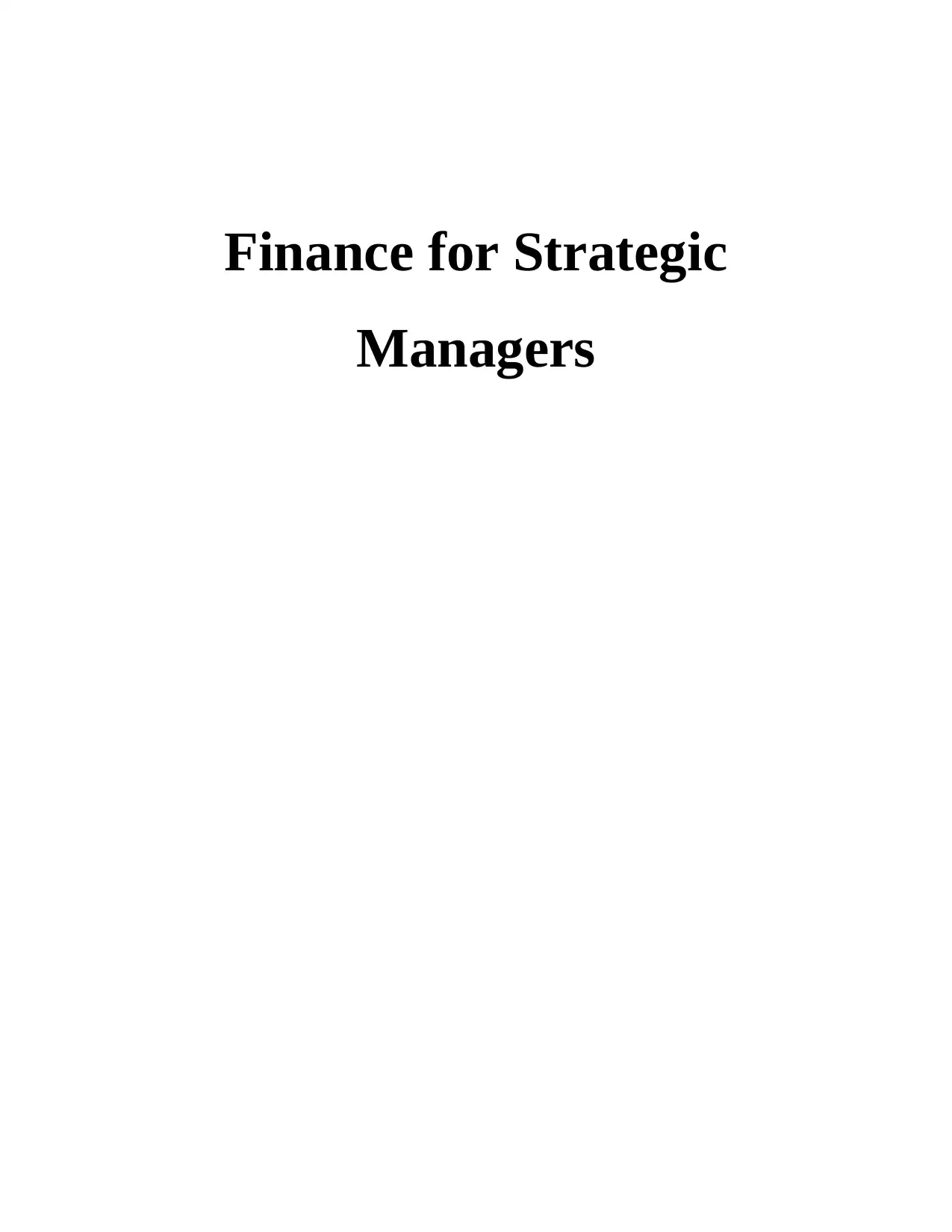
Finance for Strategic
Managers
Managers
Paraphrase This Document
Need a fresh take? Get an instant paraphrase of this document with our AI Paraphraser

TABLE OF CONTENTS
INTRODUCTION...........................................................................................................................1
TASK 1............................................................................................................................................1
1. Sources of financial data....................................................................................................1
2. Need for financial data and designing of strategy for business..........................................2
3. Risks associated with financial business decisions............................................................2
4. Methods used for appraising capital expenditure projects for business.............................3
TASK 2............................................................................................................................................4
1. Interpretation of financial statements.................................................................................4
2. Ratio analysis for Samsung Plc..........................................................................................5
TASK 3............................................................................................................................................6
1. Creative accounting techniques..........................................................................................6
2. Limitations of ratios...........................................................................................................7
3. Significance of cash flow management..............................................................................7
TASK 4............................................................................................................................................7
1. Report having assessment of capital investment techniques..............................................7
CONCLUSION................................................................................................................................9
REFERENCES..............................................................................................................................10
INTRODUCTION...........................................................................................................................1
TASK 1............................................................................................................................................1
1. Sources of financial data....................................................................................................1
2. Need for financial data and designing of strategy for business..........................................2
3. Risks associated with financial business decisions............................................................2
4. Methods used for appraising capital expenditure projects for business.............................3
TASK 2............................................................................................................................................4
1. Interpretation of financial statements.................................................................................4
2. Ratio analysis for Samsung Plc..........................................................................................5
TASK 3............................................................................................................................................6
1. Creative accounting techniques..........................................................................................6
2. Limitations of ratios...........................................................................................................7
3. Significance of cash flow management..............................................................................7
TASK 4............................................................................................................................................7
1. Report having assessment of capital investment techniques..............................................7
CONCLUSION................................................................................................................................9
REFERENCES..............................................................................................................................10
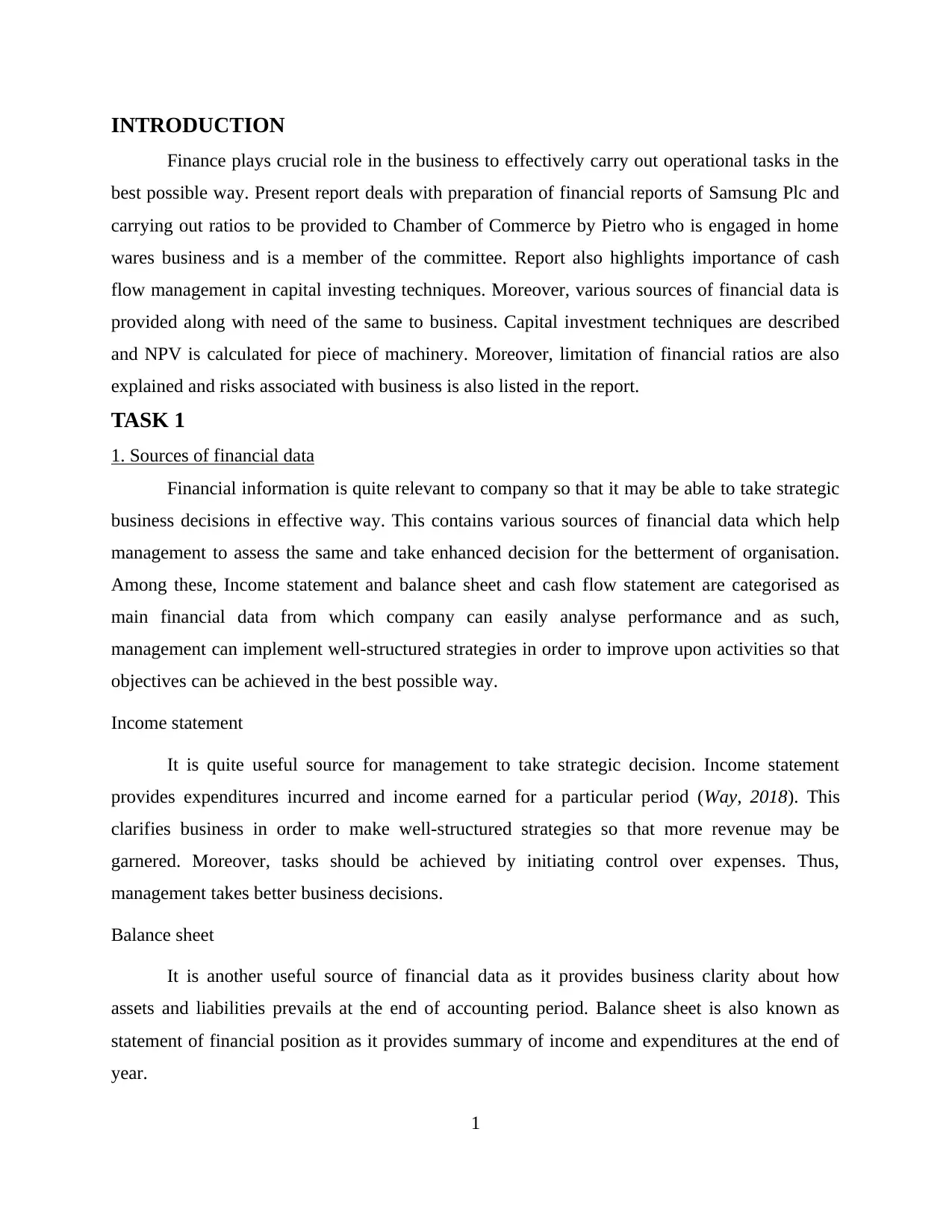
INTRODUCTION
Finance plays crucial role in the business to effectively carry out operational tasks in the
best possible way. Present report deals with preparation of financial reports of Samsung Plc and
carrying out ratios to be provided to Chamber of Commerce by Pietro who is engaged in home
wares business and is a member of the committee. Report also highlights importance of cash
flow management in capital investing techniques. Moreover, various sources of financial data is
provided along with need of the same to business. Capital investment techniques are described
and NPV is calculated for piece of machinery. Moreover, limitation of financial ratios are also
explained and risks associated with business is also listed in the report.
TASK 1
1. Sources of financial data
Financial information is quite relevant to company so that it may be able to take strategic
business decisions in effective way. This contains various sources of financial data which help
management to assess the same and take enhanced decision for the betterment of organisation.
Among these, Income statement and balance sheet and cash flow statement are categorised as
main financial data from which company can easily analyse performance and as such,
management can implement well-structured strategies in order to improve upon activities so that
objectives can be achieved in the best possible way.
Income statement
It is quite useful source for management to take strategic decision. Income statement
provides expenditures incurred and income earned for a particular period (Way, 2018). This
clarifies business in order to make well-structured strategies so that more revenue may be
garnered. Moreover, tasks should be achieved by initiating control over expenses. Thus,
management takes better business decisions.
Balance sheet
It is another useful source of financial data as it provides business clarity about how
assets and liabilities prevails at the end of accounting period. Balance sheet is also known as
statement of financial position as it provides summary of income and expenditures at the end of
year.
1
Finance plays crucial role in the business to effectively carry out operational tasks in the
best possible way. Present report deals with preparation of financial reports of Samsung Plc and
carrying out ratios to be provided to Chamber of Commerce by Pietro who is engaged in home
wares business and is a member of the committee. Report also highlights importance of cash
flow management in capital investing techniques. Moreover, various sources of financial data is
provided along with need of the same to business. Capital investment techniques are described
and NPV is calculated for piece of machinery. Moreover, limitation of financial ratios are also
explained and risks associated with business is also listed in the report.
TASK 1
1. Sources of financial data
Financial information is quite relevant to company so that it may be able to take strategic
business decisions in effective way. This contains various sources of financial data which help
management to assess the same and take enhanced decision for the betterment of organisation.
Among these, Income statement and balance sheet and cash flow statement are categorised as
main financial data from which company can easily analyse performance and as such,
management can implement well-structured strategies in order to improve upon activities so that
objectives can be achieved in the best possible way.
Income statement
It is quite useful source for management to take strategic decision. Income statement
provides expenditures incurred and income earned for a particular period (Way, 2018). This
clarifies business in order to make well-structured strategies so that more revenue may be
garnered. Moreover, tasks should be achieved by initiating control over expenses. Thus,
management takes better business decisions.
Balance sheet
It is another useful source of financial data as it provides business clarity about how
assets and liabilities prevails at the end of accounting period. Balance sheet is also known as
statement of financial position as it provides summary of income and expenditures at the end of
year.
1
⊘ This is a preview!⊘
Do you want full access?
Subscribe today to unlock all pages.

Trusted by 1+ million students worldwide

Cash flow statement
Cash flow statement is another source of financial data which particularly imparts cash
position of business entity. It includes various activities such as operating, investing and
financing activities. This help management to assess liquidity position of firm and analyse
whether sufficient working capital is there or not.
2. Need for financial data and designing of strategy for business
There is immense need of financial data in the business so that strategies can be made and
implemented in the best possible way. This is quite important for organisation as without
financial data, management may not be able to analyse shortcomings prevailing in the company.
This implies that financial data has importance to management so that necessary improvements
may be accomplished in the best possible way (Ginter, Duncan and Swayne, 2018). Balance
sheet is quite relevant as it imparts financial health of organisation for a particular accounting
period. There is need for preparing balance sheet so that if assets are less in quantity then
liabilities, then business is required to implement corrective action. This will help organisation to
formulate strategy by restricting use of liabilities and more usage of assets. Thus, solvency
position can be enhanced in a better way.
Income statement is also needed in business so that income and expenditures can be
effectively analysed in the best possible way. Operating results will be provided to management
such as sales made, expenses incurred, profit made or loss incurred. This help managers to
effectively analysed operating results and as such, enhanced decisions can be taken to provide
stockholders' maximum benefit. Apart from this, cash flow statement imparts organisation to
assess cash position in effectual way. Working capital is required in order to accomplish daily
operational tasks. Management evaluates need of extra working capital by initiating strategies to
have effective current assets in order to pay short-term liabilities. Thus, financial data help
company to formulate strategies in effectual manner (Falkheimer and et.al, 2017).
3. Risks associated with financial business decisions
There are several risks which are associated with making business decisions. In relation
to this, financial risk and business risk are major affecting business decisions. Financial risk is
associated with company's ability to produce profit so that it may be able to pay-off debts within
stipulated time. This is required in order to meet liabilities in effective way and decreasing
2
Cash flow statement is another source of financial data which particularly imparts cash
position of business entity. It includes various activities such as operating, investing and
financing activities. This help management to assess liquidity position of firm and analyse
whether sufficient working capital is there or not.
2. Need for financial data and designing of strategy for business
There is immense need of financial data in the business so that strategies can be made and
implemented in the best possible way. This is quite important for organisation as without
financial data, management may not be able to analyse shortcomings prevailing in the company.
This implies that financial data has importance to management so that necessary improvements
may be accomplished in the best possible way (Ginter, Duncan and Swayne, 2018). Balance
sheet is quite relevant as it imparts financial health of organisation for a particular accounting
period. There is need for preparing balance sheet so that if assets are less in quantity then
liabilities, then business is required to implement corrective action. This will help organisation to
formulate strategy by restricting use of liabilities and more usage of assets. Thus, solvency
position can be enhanced in a better way.
Income statement is also needed in business so that income and expenditures can be
effectively analysed in the best possible way. Operating results will be provided to management
such as sales made, expenses incurred, profit made or loss incurred. This help managers to
effectively analysed operating results and as such, enhanced decisions can be taken to provide
stockholders' maximum benefit. Apart from this, cash flow statement imparts organisation to
assess cash position in effectual way. Working capital is required in order to accomplish daily
operational tasks. Management evaluates need of extra working capital by initiating strategies to
have effective current assets in order to pay short-term liabilities. Thus, financial data help
company to formulate strategies in effectual manner (Falkheimer and et.al, 2017).
3. Risks associated with financial business decisions
There are several risks which are associated with making business decisions. In relation
to this, financial risk and business risk are major affecting business decisions. Financial risk is
associated with company's ability to produce profit so that it may be able to pay-off debts within
stipulated time. This is required in order to meet liabilities in effective way and decreasing
2
Paraphrase This Document
Need a fresh take? Get an instant paraphrase of this document with our AI Paraphraser
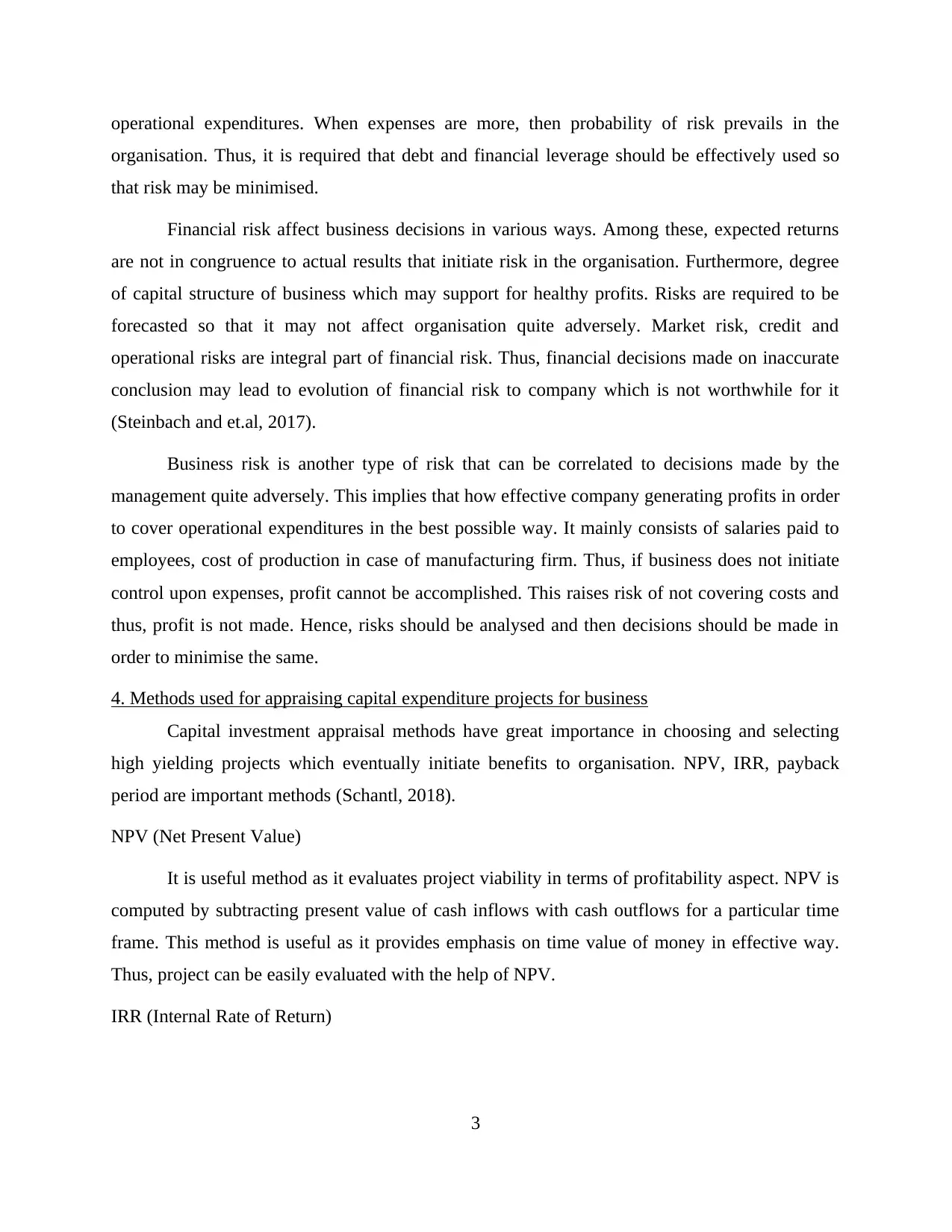
operational expenditures. When expenses are more, then probability of risk prevails in the
organisation. Thus, it is required that debt and financial leverage should be effectively used so
that risk may be minimised.
Financial risk affect business decisions in various ways. Among these, expected returns
are not in congruence to actual results that initiate risk in the organisation. Furthermore, degree
of capital structure of business which may support for healthy profits. Risks are required to be
forecasted so that it may not affect organisation quite adversely. Market risk, credit and
operational risks are integral part of financial risk. Thus, financial decisions made on inaccurate
conclusion may lead to evolution of financial risk to company which is not worthwhile for it
(Steinbach and et.al, 2017).
Business risk is another type of risk that can be correlated to decisions made by the
management quite adversely. This implies that how effective company generating profits in order
to cover operational expenditures in the best possible way. It mainly consists of salaries paid to
employees, cost of production in case of manufacturing firm. Thus, if business does not initiate
control upon expenses, profit cannot be accomplished. This raises risk of not covering costs and
thus, profit is not made. Hence, risks should be analysed and then decisions should be made in
order to minimise the same.
4. Methods used for appraising capital expenditure projects for business
Capital investment appraisal methods have great importance in choosing and selecting
high yielding projects which eventually initiate benefits to organisation. NPV, IRR, payback
period are important methods (Schantl, 2018).
NPV (Net Present Value)
It is useful method as it evaluates project viability in terms of profitability aspect. NPV is
computed by subtracting present value of cash inflows with cash outflows for a particular time
frame. This method is useful as it provides emphasis on time value of money in effective way.
Thus, project can be easily evaluated with the help of NPV.
IRR (Internal Rate of Return)
3
organisation. Thus, it is required that debt and financial leverage should be effectively used so
that risk may be minimised.
Financial risk affect business decisions in various ways. Among these, expected returns
are not in congruence to actual results that initiate risk in the organisation. Furthermore, degree
of capital structure of business which may support for healthy profits. Risks are required to be
forecasted so that it may not affect organisation quite adversely. Market risk, credit and
operational risks are integral part of financial risk. Thus, financial decisions made on inaccurate
conclusion may lead to evolution of financial risk to company which is not worthwhile for it
(Steinbach and et.al, 2017).
Business risk is another type of risk that can be correlated to decisions made by the
management quite adversely. This implies that how effective company generating profits in order
to cover operational expenditures in the best possible way. It mainly consists of salaries paid to
employees, cost of production in case of manufacturing firm. Thus, if business does not initiate
control upon expenses, profit cannot be accomplished. This raises risk of not covering costs and
thus, profit is not made. Hence, risks should be analysed and then decisions should be made in
order to minimise the same.
4. Methods used for appraising capital expenditure projects for business
Capital investment appraisal methods have great importance in choosing and selecting
high yielding projects which eventually initiate benefits to organisation. NPV, IRR, payback
period are important methods (Schantl, 2018).
NPV (Net Present Value)
It is useful method as it evaluates project viability in terms of profitability aspect. NPV is
computed by subtracting present value of cash inflows with cash outflows for a particular time
frame. This method is useful as it provides emphasis on time value of money in effective way.
Thus, project can be easily evaluated with the help of NPV.
IRR (Internal Rate of Return)
3
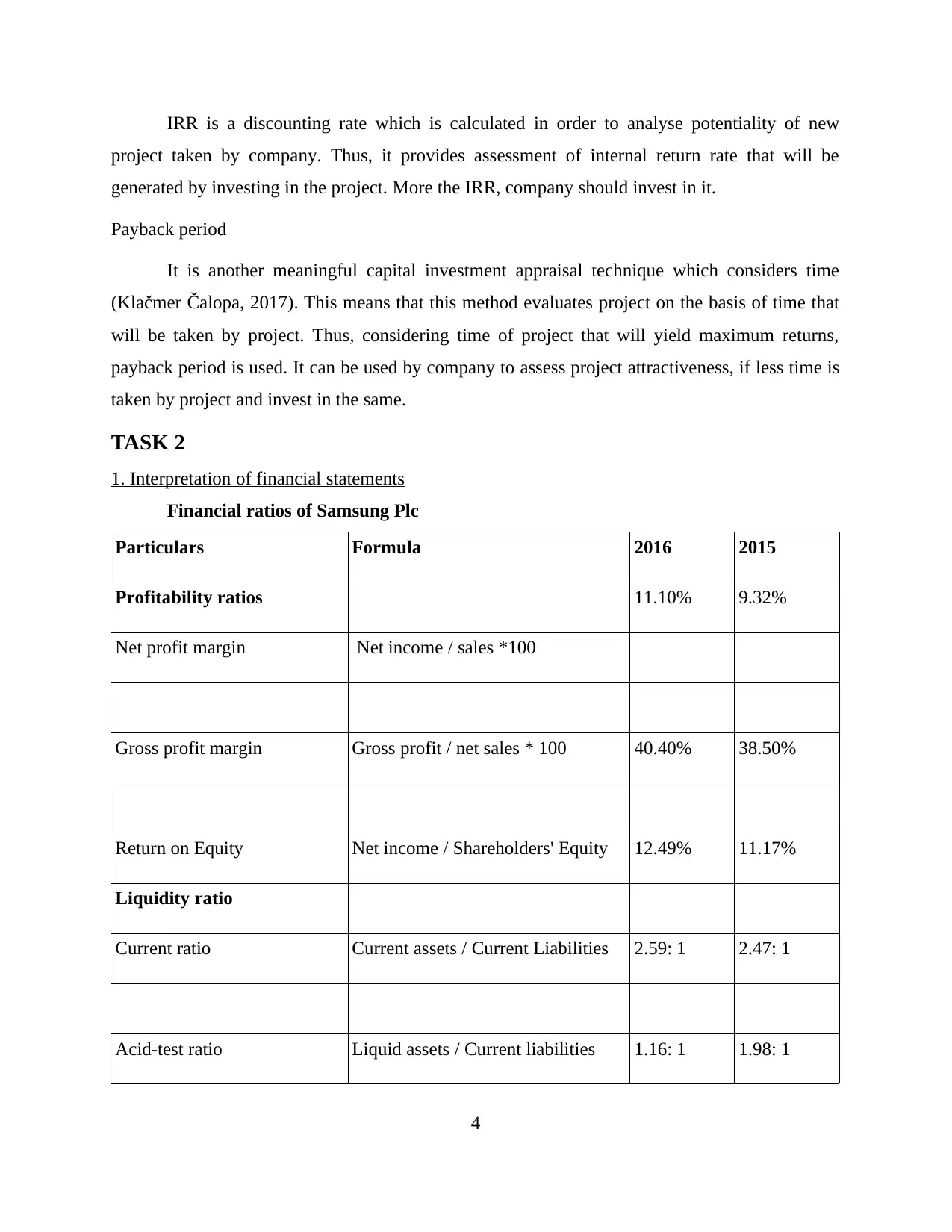
IRR is a discounting rate which is calculated in order to analyse potentiality of new
project taken by company. Thus, it provides assessment of internal return rate that will be
generated by investing in the project. More the IRR, company should invest in it.
Payback period
It is another meaningful capital investment appraisal technique which considers time
(Klačmer Čalopa, 2017). This means that this method evaluates project on the basis of time that
will be taken by project. Thus, considering time of project that will yield maximum returns,
payback period is used. It can be used by company to assess project attractiveness, if less time is
taken by project and invest in the same.
TASK 2
1. Interpretation of financial statements
Financial ratios of Samsung Plc
Particulars Formula 2016 2015
Profitability ratios 11.10% 9.32%
Net profit margin Net income / sales *100
Gross profit margin Gross profit / net sales * 100 40.40% 38.50%
Return on Equity Net income / Shareholders' Equity 12.49% 11.17%
Liquidity ratio
Current ratio Current assets / Current Liabilities 2.59: 1 2.47: 1
Acid-test ratio Liquid assets / Current liabilities 1.16: 1 1.98: 1
4
project taken by company. Thus, it provides assessment of internal return rate that will be
generated by investing in the project. More the IRR, company should invest in it.
Payback period
It is another meaningful capital investment appraisal technique which considers time
(Klačmer Čalopa, 2017). This means that this method evaluates project on the basis of time that
will be taken by project. Thus, considering time of project that will yield maximum returns,
payback period is used. It can be used by company to assess project attractiveness, if less time is
taken by project and invest in the same.
TASK 2
1. Interpretation of financial statements
Financial ratios of Samsung Plc
Particulars Formula 2016 2015
Profitability ratios 11.10% 9.32%
Net profit margin Net income / sales *100
Gross profit margin Gross profit / net sales * 100 40.40% 38.50%
Return on Equity Net income / Shareholders' Equity 12.49% 11.17%
Liquidity ratio
Current ratio Current assets / Current Liabilities 2.59: 1 2.47: 1
Acid-test ratio Liquid assets / Current liabilities 1.16: 1 1.98: 1
4
⊘ This is a preview!⊘
Do you want full access?
Subscribe today to unlock all pages.

Trusted by 1+ million students worldwide
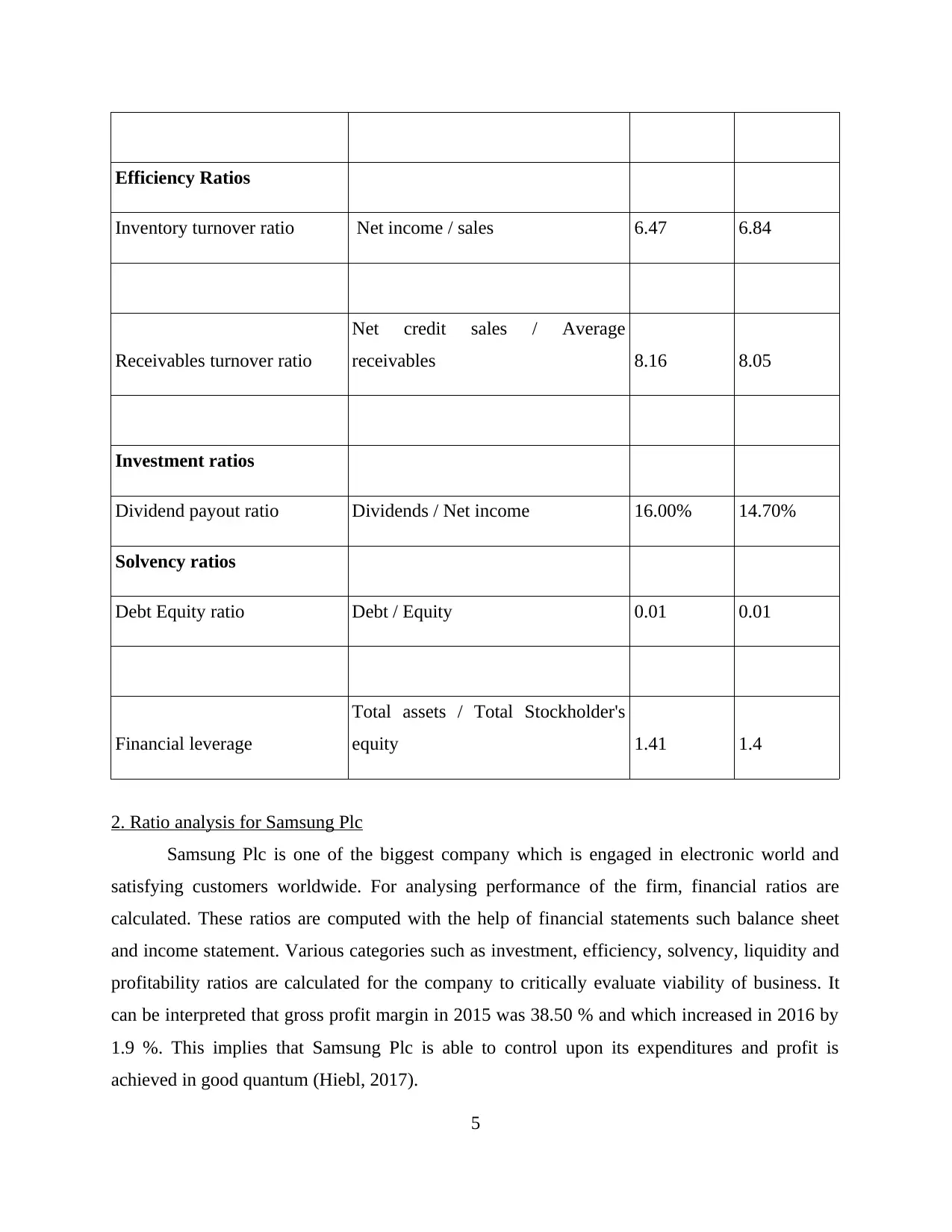
Efficiency Ratios
Inventory turnover ratio Net income / sales 6.47 6.84
Receivables turnover ratio
Net credit sales / Average
receivables 8.16 8.05
Investment ratios
Dividend payout ratio Dividends / Net income 16.00% 14.70%
Solvency ratios
Debt Equity ratio Debt / Equity 0.01 0.01
Financial leverage
Total assets / Total Stockholder's
equity 1.41 1.4
2. Ratio analysis for Samsung Plc
Samsung Plc is one of the biggest company which is engaged in electronic world and
satisfying customers worldwide. For analysing performance of the firm, financial ratios are
calculated. These ratios are computed with the help of financial statements such balance sheet
and income statement. Various categories such as investment, efficiency, solvency, liquidity and
profitability ratios are calculated for the company to critically evaluate viability of business. It
can be interpreted that gross profit margin in 2015 was 38.50 % and which increased in 2016 by
1.9 %. This implies that Samsung Plc is able to control upon its expenditures and profit is
achieved in good quantum (Hiebl, 2017).
5
Inventory turnover ratio Net income / sales 6.47 6.84
Receivables turnover ratio
Net credit sales / Average
receivables 8.16 8.05
Investment ratios
Dividend payout ratio Dividends / Net income 16.00% 14.70%
Solvency ratios
Debt Equity ratio Debt / Equity 0.01 0.01
Financial leverage
Total assets / Total Stockholder's
equity 1.41 1.4
2. Ratio analysis for Samsung Plc
Samsung Plc is one of the biggest company which is engaged in electronic world and
satisfying customers worldwide. For analysing performance of the firm, financial ratios are
calculated. These ratios are computed with the help of financial statements such balance sheet
and income statement. Various categories such as investment, efficiency, solvency, liquidity and
profitability ratios are calculated for the company to critically evaluate viability of business. It
can be interpreted that gross profit margin in 2015 was 38.50 % and which increased in 2016 by
1.9 %. This implies that Samsung Plc is able to control upon its expenditures and profit is
achieved in good quantum (Hiebl, 2017).
5
Paraphrase This Document
Need a fresh take? Get an instant paraphrase of this document with our AI Paraphraser
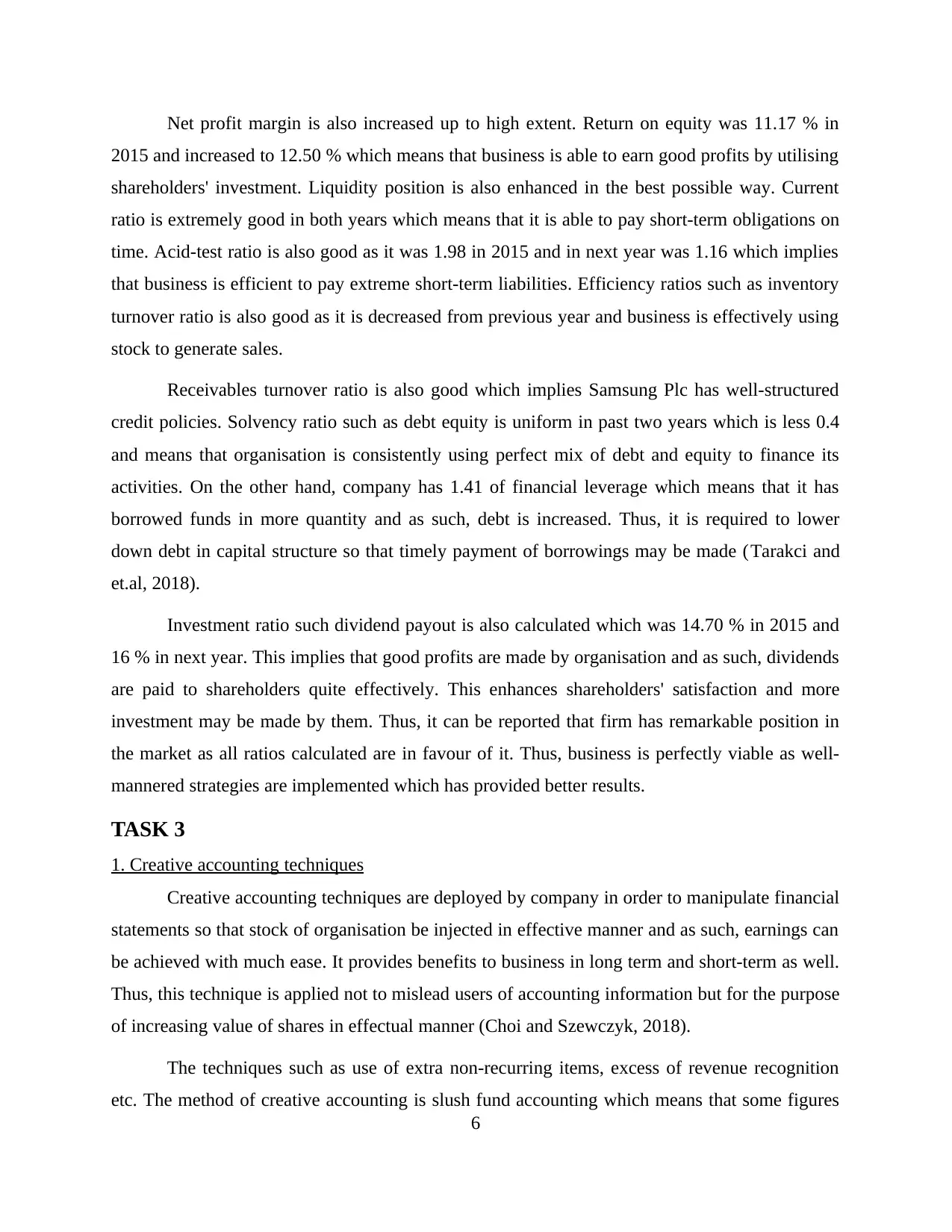
Net profit margin is also increased up to high extent. Return on equity was 11.17 % in
2015 and increased to 12.50 % which means that business is able to earn good profits by utilising
shareholders' investment. Liquidity position is also enhanced in the best possible way. Current
ratio is extremely good in both years which means that it is able to pay short-term obligations on
time. Acid-test ratio is also good as it was 1.98 in 2015 and in next year was 1.16 which implies
that business is efficient to pay extreme short-term liabilities. Efficiency ratios such as inventory
turnover ratio is also good as it is decreased from previous year and business is effectively using
stock to generate sales.
Receivables turnover ratio is also good which implies Samsung Plc has well-structured
credit policies. Solvency ratio such as debt equity is uniform in past two years which is less 0.4
and means that organisation is consistently using perfect mix of debt and equity to finance its
activities. On the other hand, company has 1.41 of financial leverage which means that it has
borrowed funds in more quantity and as such, debt is increased. Thus, it is required to lower
down debt in capital structure so that timely payment of borrowings may be made (Tarakci and
et.al, 2018).
Investment ratio such dividend payout is also calculated which was 14.70 % in 2015 and
16 % in next year. This implies that good profits are made by organisation and as such, dividends
are paid to shareholders quite effectively. This enhances shareholders' satisfaction and more
investment may be made by them. Thus, it can be reported that firm has remarkable position in
the market as all ratios calculated are in favour of it. Thus, business is perfectly viable as well-
mannered strategies are implemented which has provided better results.
TASK 3
1. Creative accounting techniques
Creative accounting techniques are deployed by company in order to manipulate financial
statements so that stock of organisation be injected in effective manner and as such, earnings can
be achieved with much ease. It provides benefits to business in long term and short-term as well.
Thus, this technique is applied not to mislead users of accounting information but for the purpose
of increasing value of shares in effectual manner (Choi and Szewczyk, 2018).
The techniques such as use of extra non-recurring items, excess of revenue recognition
etc. The method of creative accounting is slush fund accounting which means that some figures
6
2015 and increased to 12.50 % which means that business is able to earn good profits by utilising
shareholders' investment. Liquidity position is also enhanced in the best possible way. Current
ratio is extremely good in both years which means that it is able to pay short-term obligations on
time. Acid-test ratio is also good as it was 1.98 in 2015 and in next year was 1.16 which implies
that business is efficient to pay extreme short-term liabilities. Efficiency ratios such as inventory
turnover ratio is also good as it is decreased from previous year and business is effectively using
stock to generate sales.
Receivables turnover ratio is also good which implies Samsung Plc has well-structured
credit policies. Solvency ratio such as debt equity is uniform in past two years which is less 0.4
and means that organisation is consistently using perfect mix of debt and equity to finance its
activities. On the other hand, company has 1.41 of financial leverage which means that it has
borrowed funds in more quantity and as such, debt is increased. Thus, it is required to lower
down debt in capital structure so that timely payment of borrowings may be made (Tarakci and
et.al, 2018).
Investment ratio such dividend payout is also calculated which was 14.70 % in 2015 and
16 % in next year. This implies that good profits are made by organisation and as such, dividends
are paid to shareholders quite effectively. This enhances shareholders' satisfaction and more
investment may be made by them. Thus, it can be reported that firm has remarkable position in
the market as all ratios calculated are in favour of it. Thus, business is perfectly viable as well-
mannered strategies are implemented which has provided better results.
TASK 3
1. Creative accounting techniques
Creative accounting techniques are deployed by company in order to manipulate financial
statements so that stock of organisation be injected in effective manner and as such, earnings can
be achieved with much ease. It provides benefits to business in long term and short-term as well.
Thus, this technique is applied not to mislead users of accounting information but for the purpose
of increasing value of shares in effectual manner (Choi and Szewczyk, 2018).
The techniques such as use of extra non-recurring items, excess of revenue recognition
etc. The method of creative accounting is slush fund accounting which means that some figures
6
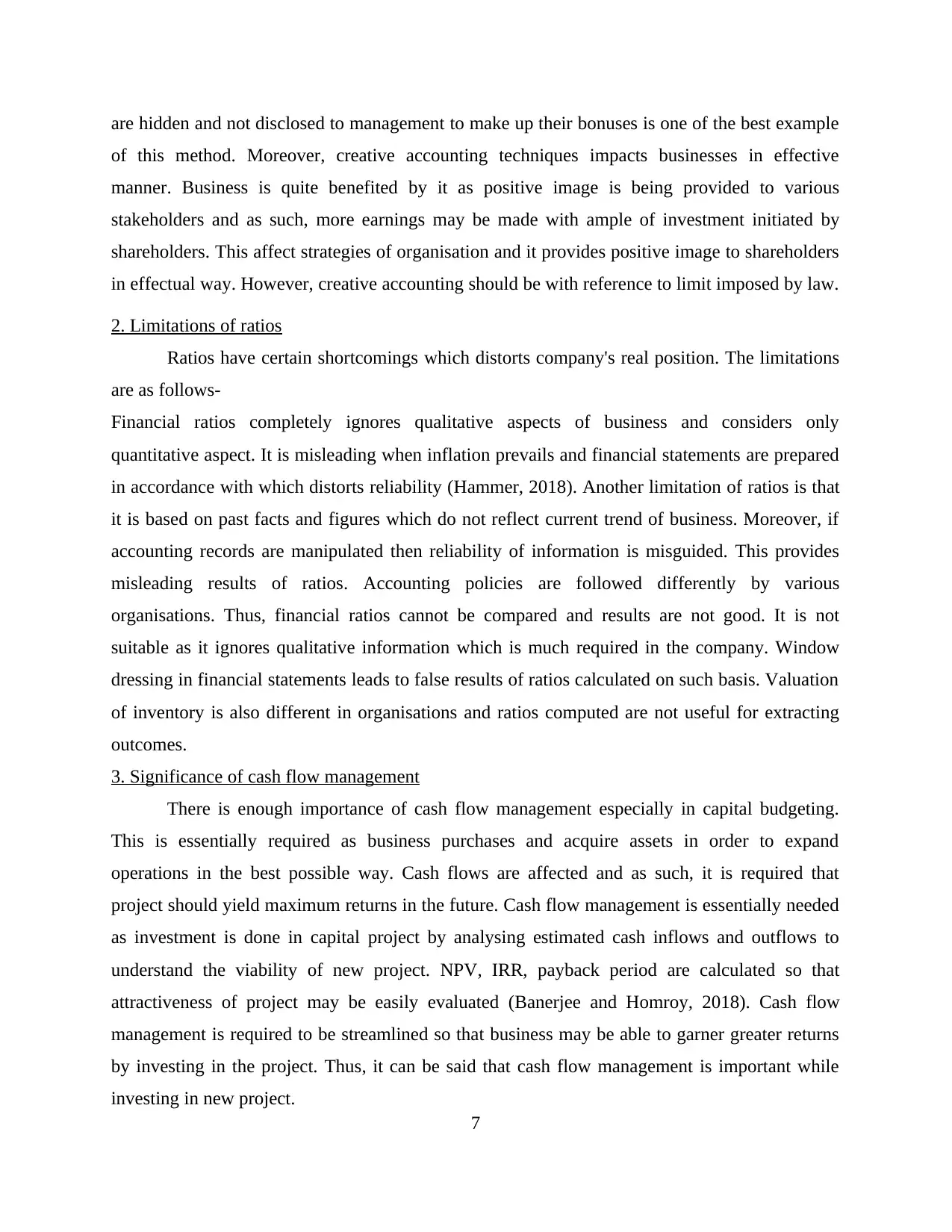
are hidden and not disclosed to management to make up their bonuses is one of the best example
of this method. Moreover, creative accounting techniques impacts businesses in effective
manner. Business is quite benefited by it as positive image is being provided to various
stakeholders and as such, more earnings may be made with ample of investment initiated by
shareholders. This affect strategies of organisation and it provides positive image to shareholders
in effectual way. However, creative accounting should be with reference to limit imposed by law.
2. Limitations of ratios
Ratios have certain shortcomings which distorts company's real position. The limitations
are as follows-
Financial ratios completely ignores qualitative aspects of business and considers only
quantitative aspect. It is misleading when inflation prevails and financial statements are prepared
in accordance with which distorts reliability (Hammer, 2018). Another limitation of ratios is that
it is based on past facts and figures which do not reflect current trend of business. Moreover, if
accounting records are manipulated then reliability of information is misguided. This provides
misleading results of ratios. Accounting policies are followed differently by various
organisations. Thus, financial ratios cannot be compared and results are not good. It is not
suitable as it ignores qualitative information which is much required in the company. Window
dressing in financial statements leads to false results of ratios calculated on such basis. Valuation
of inventory is also different in organisations and ratios computed are not useful for extracting
outcomes.
3. Significance of cash flow management
There is enough importance of cash flow management especially in capital budgeting.
This is essentially required as business purchases and acquire assets in order to expand
operations in the best possible way. Cash flows are affected and as such, it is required that
project should yield maximum returns in the future. Cash flow management is essentially needed
as investment is done in capital project by analysing estimated cash inflows and outflows to
understand the viability of new project. NPV, IRR, payback period are calculated so that
attractiveness of project may be easily evaluated (Banerjee and Homroy, 2018). Cash flow
management is required to be streamlined so that business may be able to garner greater returns
by investing in the project. Thus, it can be said that cash flow management is important while
investing in new project.
7
of this method. Moreover, creative accounting techniques impacts businesses in effective
manner. Business is quite benefited by it as positive image is being provided to various
stakeholders and as such, more earnings may be made with ample of investment initiated by
shareholders. This affect strategies of organisation and it provides positive image to shareholders
in effectual way. However, creative accounting should be with reference to limit imposed by law.
2. Limitations of ratios
Ratios have certain shortcomings which distorts company's real position. The limitations
are as follows-
Financial ratios completely ignores qualitative aspects of business and considers only
quantitative aspect. It is misleading when inflation prevails and financial statements are prepared
in accordance with which distorts reliability (Hammer, 2018). Another limitation of ratios is that
it is based on past facts and figures which do not reflect current trend of business. Moreover, if
accounting records are manipulated then reliability of information is misguided. This provides
misleading results of ratios. Accounting policies are followed differently by various
organisations. Thus, financial ratios cannot be compared and results are not good. It is not
suitable as it ignores qualitative information which is much required in the company. Window
dressing in financial statements leads to false results of ratios calculated on such basis. Valuation
of inventory is also different in organisations and ratios computed are not useful for extracting
outcomes.
3. Significance of cash flow management
There is enough importance of cash flow management especially in capital budgeting.
This is essentially required as business purchases and acquire assets in order to expand
operations in the best possible way. Cash flows are affected and as such, it is required that
project should yield maximum returns in the future. Cash flow management is essentially needed
as investment is done in capital project by analysing estimated cash inflows and outflows to
understand the viability of new project. NPV, IRR, payback period are calculated so that
attractiveness of project may be easily evaluated (Banerjee and Homroy, 2018). Cash flow
management is required to be streamlined so that business may be able to garner greater returns
by investing in the project. Thus, it can be said that cash flow management is important while
investing in new project.
7
⊘ This is a preview!⊘
Do you want full access?
Subscribe today to unlock all pages.

Trusted by 1+ million students worldwide

TASK 4
1. Report having assessment of capital investment techniques
Current machine
Year Cash flows PV factor @ 15 % Discounted cash flows
0
1 207000 0.87 180090
2 94000 0.756 71064
3 150000 0.658 98700
349854
Initial Investment 260000
NPV 89854
New machine
Year Cash flows
PV factor @ 15
%
0
1 216450 0.87 188311.5
2 91375 0.756 69079.5
3 53958.75 0.658 35504.8575
292895.8575
Initial 220000
8
1. Report having assessment of capital investment techniques
Current machine
Year Cash flows PV factor @ 15 % Discounted cash flows
0
1 207000 0.87 180090
2 94000 0.756 71064
3 150000 0.658 98700
349854
Initial Investment 260000
NPV 89854
New machine
Year Cash flows
PV factor @ 15
%
0
1 216450 0.87 188311.5
2 91375 0.756 69079.5
3 53958.75 0.658 35504.8575
292895.8575
Initial 220000
8
Paraphrase This Document
Need a fresh take? Get an instant paraphrase of this document with our AI Paraphraser
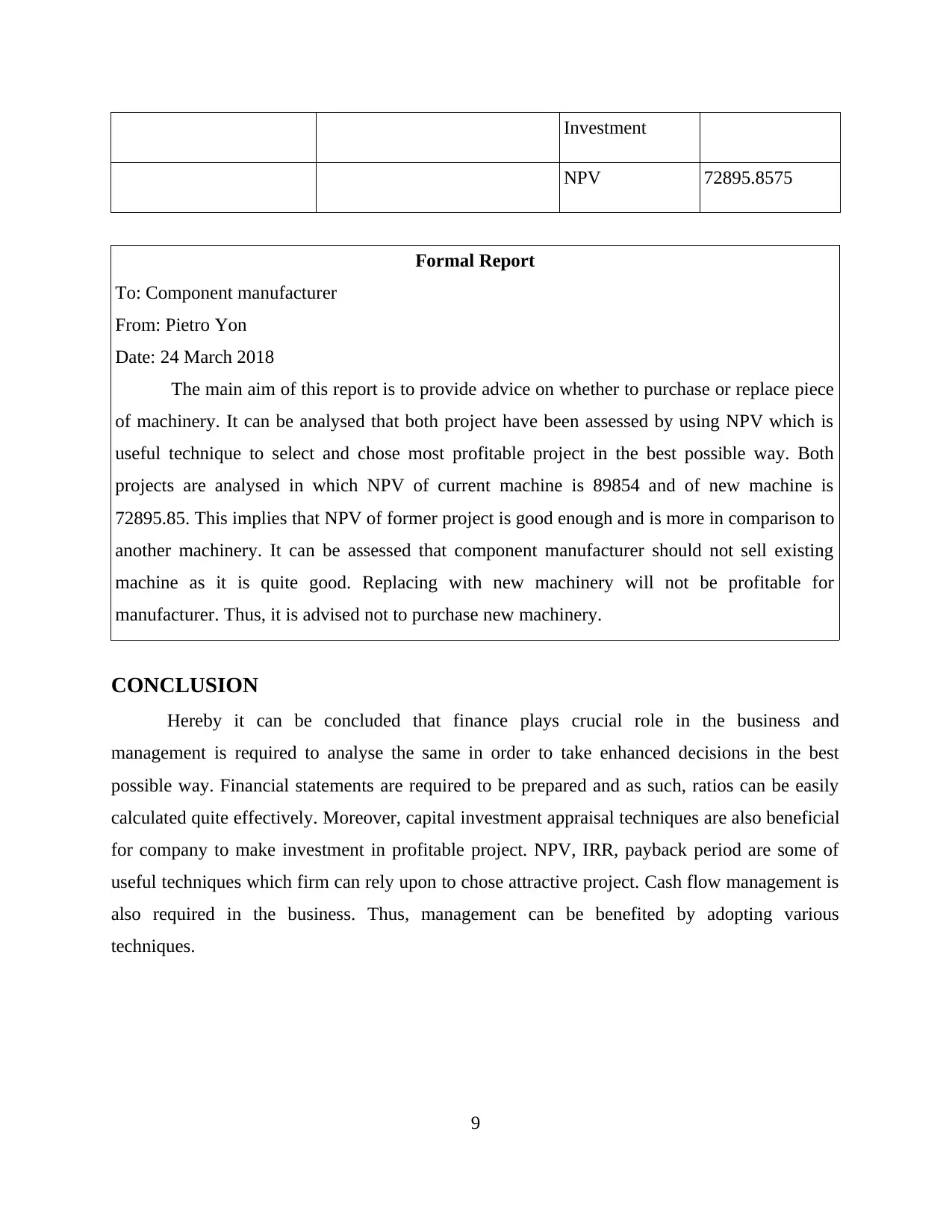
Investment
NPV 72895.8575
Formal Report
To: Component manufacturer
From: Pietro Yon
Date: 24 March 2018
The main aim of this report is to provide advice on whether to purchase or replace piece
of machinery. It can be analysed that both project have been assessed by using NPV which is
useful technique to select and chose most profitable project in the best possible way. Both
projects are analysed in which NPV of current machine is 89854 and of new machine is
72895.85. This implies that NPV of former project is good enough and is more in comparison to
another machinery. It can be assessed that component manufacturer should not sell existing
machine as it is quite good. Replacing with new machinery will not be profitable for
manufacturer. Thus, it is advised not to purchase new machinery.
CONCLUSION
Hereby it can be concluded that finance plays crucial role in the business and
management is required to analyse the same in order to take enhanced decisions in the best
possible way. Financial statements are required to be prepared and as such, ratios can be easily
calculated quite effectively. Moreover, capital investment appraisal techniques are also beneficial
for company to make investment in profitable project. NPV, IRR, payback period are some of
useful techniques which firm can rely upon to chose attractive project. Cash flow management is
also required in the business. Thus, management can be benefited by adopting various
techniques.
9
NPV 72895.8575
Formal Report
To: Component manufacturer
From: Pietro Yon
Date: 24 March 2018
The main aim of this report is to provide advice on whether to purchase or replace piece
of machinery. It can be analysed that both project have been assessed by using NPV which is
useful technique to select and chose most profitable project in the best possible way. Both
projects are analysed in which NPV of current machine is 89854 and of new machine is
72895.85. This implies that NPV of former project is good enough and is more in comparison to
another machinery. It can be assessed that component manufacturer should not sell existing
machine as it is quite good. Replacing with new machinery will not be profitable for
manufacturer. Thus, it is advised not to purchase new machinery.
CONCLUSION
Hereby it can be concluded that finance plays crucial role in the business and
management is required to analyse the same in order to take enhanced decisions in the best
possible way. Financial statements are required to be prepared and as such, ratios can be easily
calculated quite effectively. Moreover, capital investment appraisal techniques are also beneficial
for company to make investment in profitable project. NPV, IRR, payback period are some of
useful techniques which firm can rely upon to chose attractive project. Cash flow management is
also required in the business. Thus, management can be benefited by adopting various
techniques.
9
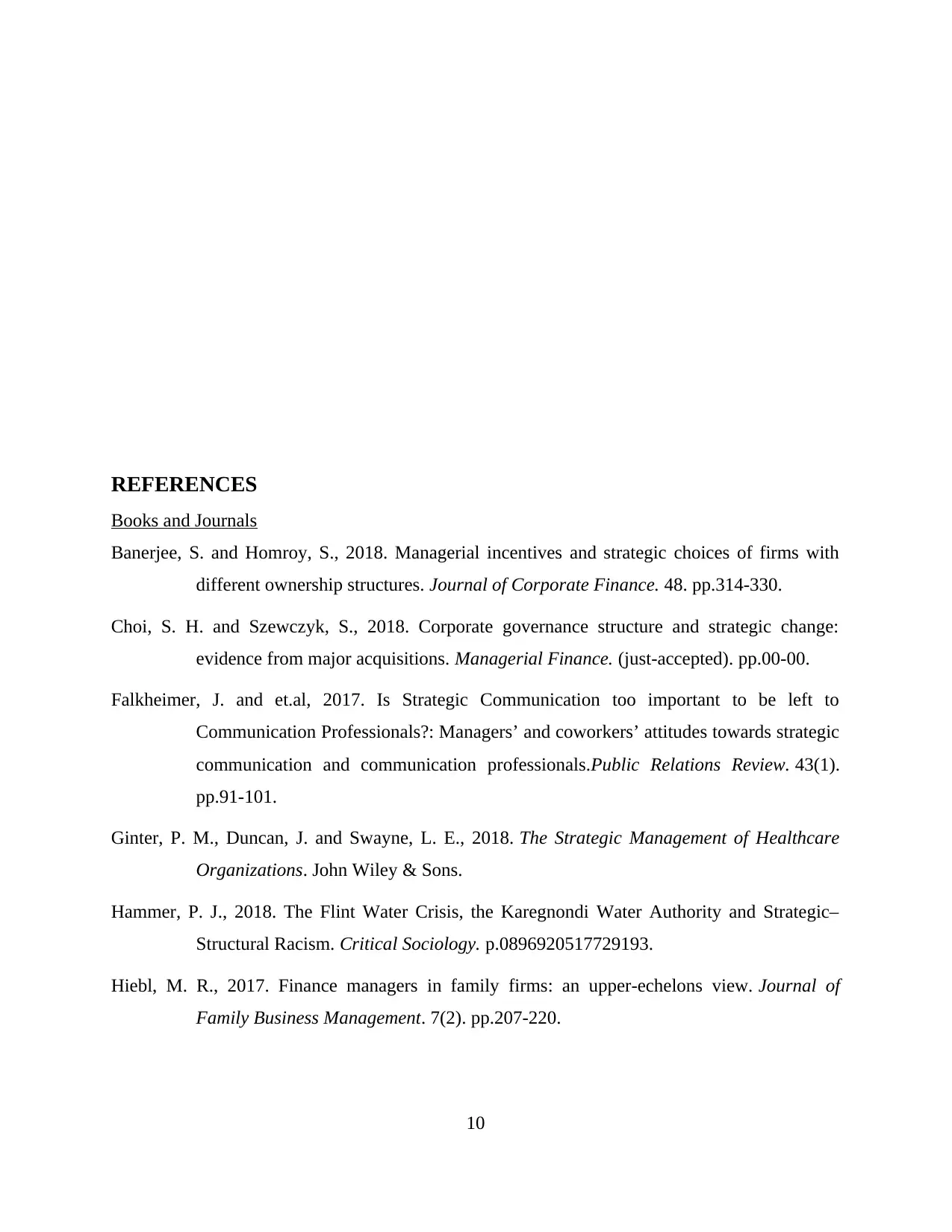
REFERENCES
Books and Journals
Banerjee, S. and Homroy, S., 2018. Managerial incentives and strategic choices of firms with
different ownership structures. Journal of Corporate Finance. 48. pp.314-330.
Choi, S. H. and Szewczyk, S., 2018. Corporate governance structure and strategic change:
evidence from major acquisitions. Managerial Finance. (just-accepted). pp.00-00.
Falkheimer, J. and et.al, 2017. Is Strategic Communication too important to be left to
Communication Professionals?: Managers’ and coworkers’ attitudes towards strategic
communication and communication professionals.Public Relations Review. 43(1).
pp.91-101.
Ginter, P. M., Duncan, J. and Swayne, L. E., 2018. The Strategic Management of Healthcare
Organizations. John Wiley & Sons.
Hammer, P. J., 2018. The Flint Water Crisis, the Karegnondi Water Authority and Strategic–
Structural Racism. Critical Sociology. p.0896920517729193.
Hiebl, M. R., 2017. Finance managers in family firms: an upper-echelons view. Journal of
Family Business Management. 7(2). pp.207-220.
10
Books and Journals
Banerjee, S. and Homroy, S., 2018. Managerial incentives and strategic choices of firms with
different ownership structures. Journal of Corporate Finance. 48. pp.314-330.
Choi, S. H. and Szewczyk, S., 2018. Corporate governance structure and strategic change:
evidence from major acquisitions. Managerial Finance. (just-accepted). pp.00-00.
Falkheimer, J. and et.al, 2017. Is Strategic Communication too important to be left to
Communication Professionals?: Managers’ and coworkers’ attitudes towards strategic
communication and communication professionals.Public Relations Review. 43(1).
pp.91-101.
Ginter, P. M., Duncan, J. and Swayne, L. E., 2018. The Strategic Management of Healthcare
Organizations. John Wiley & Sons.
Hammer, P. J., 2018. The Flint Water Crisis, the Karegnondi Water Authority and Strategic–
Structural Racism. Critical Sociology. p.0896920517729193.
Hiebl, M. R., 2017. Finance managers in family firms: an upper-echelons view. Journal of
Family Business Management. 7(2). pp.207-220.
10
⊘ This is a preview!⊘
Do you want full access?
Subscribe today to unlock all pages.

Trusted by 1+ million students worldwide
1 out of 13
Related Documents
Your All-in-One AI-Powered Toolkit for Academic Success.
+13062052269
info@desklib.com
Available 24*7 on WhatsApp / Email
![[object Object]](/_next/static/media/star-bottom.7253800d.svg)
Unlock your academic potential
Copyright © 2020–2026 A2Z Services. All Rights Reserved. Developed and managed by ZUCOL.





